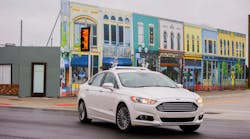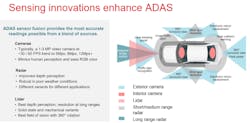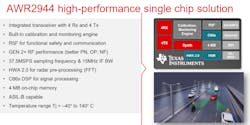TI Rolls Out High-Resolution Radar Sensor for Cars to Avert Collisions
Check out our CES 2022 coverage.
Texas Instruments is upping its bid to become a leader in the world of autonomous cars with its new millimeter-wave radar chip, which can sense its surroundings more accurately and help cars avert collisions.
TI rolled out its second-generation chip for short- to long-range automotive radar, the AWR294x family, which can support 33% higher resolution and 40% longer range than other solutions on the market. One of the world’s most prominent automobile chip firms, TI said the new millimeter-wave radar sensor puts it a step ahead of rivals such as NXP Semiconductors, Infineon Technologies, and Analog Devices.
The chips at the heart of radar sensors, which use radio waves to measure the velocity and distance to objects in a car’s surroundings, are one of the key components in the race to roll out autonomous cars.
Most radar sensors on the market now are bulky boxes containing RF components and a separate processor to pinpoint cars or other obstacles hundreds of feet ahead of the road. But TI is instead integrating a 77-GHz frequency-modulated continuous-wave (FMCW) radar transceiver with radar processing engines onto a single system-on-a-chip (SoC) around the size of a postage stamp.
TI released the first generation of its single-chip millimeter-wave radar system for cars in 2018. Since the launch, it has shipped “millions” units of the radar chip to car manufacturers and Tier-1 suppliers.
But to reduce carnage on the road, TI is upgrading its radar processors to pinpoint cars and obstacles on the road faster and more accurately, keep an eye on blind spots, and more safely switch lanes and turn corners. TI said the AWR294x could be used to bring more redundancy to Level 2 or more advanced driver assistance systems (ADAS), such as automated emergency braking (AEB) or lane-change assist.
“This is a complete upgrade,” said Yariv Raveh, general manager of millimeter-wave radar at TI, citing the improvements in the radar’s RF subsystem, computing resources, and memory.
Raising the Safety Bar
Today, the average car generally has three radar sensors that tend to be slapped on the corners of the vehicle to alert people to potential dangers in a car’s blind spots at a range of 80 meters, TI said.
But TI anticipates that cars could have eight or more radar sensors with varying resolutions and ranges in the future to create a 360-degree cocoon around the car that can flag objects up to 250 meters away.
The front- and rear-facing cameras in cars today continue to have the advantage of high resolution. They are also very affordable and compact. But for a system to achieve more rigorous safety standards and even fully autonomous driving in the future, cameras will need backup sensors such as radar and lidar that fail under different conditions, such as in stormy weather, at night, or in direct sunlight.
Radar sensors can tolerate years of jolting vibrations and harsh temperatures while mounted on cars. They are smaller and significantly cheaper than lidar sensors and can measure the velocity of objects on the road instantaneously. They can also penetrate fog, rain, and other weather that can obscure cameras and costly lidar sensors. With it, cars can pinpoint obstacles out of sight on the road ahead.
But they have long had one major disadvantage. They only have a fraction of the resolution of other sensors such as lidar and cameras, which means they can struggle to tell objects apart.
The AWR294x from TI stands out by integrating four antennas instead of the three that are standard on most radar sensors from its rivals, boosting the radar's output power. TI said that translates to a 33% boost in resolution, giving it the ability to pinpoint obstacles on the road ahead more accurately and tell the difference between cars, motorcycles, and people.
The radar sensor provides 5 GHz of available bandwidth.
Under the Radar
At the heart of TI’s radar sensor is a central processor subsystem based on a programmable lock-step Arm Cortex-R5F CPU clocked at up to 300 MHz, upgraded from the real-time Cortex-R4F CPU in its predecessor. The chip also integrates a TI-designed digital signal processor (DSP) clocked at up to 360 MHz to process radar signals into a more accurate picture of the car’s surroundings.
TI said the radar runs a more advanced type of signal processing technology called Doppler division multiple access (DDMA) that helps it pinpoint other vehicles or obstacles on the road at up to 40% further distances.
Also under the hood is a hardware accelerator (HWA 2.0) that offloads a wide range of signal processing chores from the CPU and DSP cores, freeing up resources to run more advanced radar software. TI said it doubled the on-chip memory to 4 MB, opening the door for more advanced radar software to run inside, including up to 2.5 MB of shared L3 cache physically close to the HWA.
The radar sensor also raises the bar with a programmable hardware security module (HSM), which adds layers of protection against hackers with secure boot and hardware accelerators for cryptography.
“All of these blocks would typically come in a separate device,” Raveh said. TI used its 45-nm RFCMOS process technology to fit the RF transceiver, CPU, DSP, and hardware accelerator all on the same chip.
TI said the second-generation radar is housed in a 0.65- by 12- by 12-mm flip-chip ball-grid array (FCBGA) package. As a result, TI said it is approximately 30% smaller than rivals’, saving on cost, area, and weight.
Flexibility Takes Priority
Flexibility is also one of the merits of the millimeter-wave radar sensor. TI said the software that controls inside the front end of the radar sensor is locked in place. But TI said customers can program the CPU, DSP, and HWA in the radar chip to build different types of sensors, such as short-range radar that can locate objects in a car's blind spots, assist with parking, or help navigate tight spaces.
The chip can also be configured as mid-range radar for lane-change assistance or other features or long-range radar mounted on the front of a car that can determine the distance to objects up to 250 meters (820 feet) away. TI said it could also be used as a “multimode” sensor that can adjust its range dynamically based on the resolution needed by its customers—all bundled in a single chip.
The automotive-grade radar sensor supports the ASIL-B standard for functional safety and can tolerate operating temperatures of –40°C to 140°C. The chip also has embedded self-monitoring, the company said.
The radar sensor incorporates a pair of CAN-FD ports to connect to the central processor in the system. In addition, the company said the chip is supplemented with a 10 MB/s to 100 MB/s Ethernet port. It is also loaded with I/O connectivity, including I2C, SPI, UART, and GPIOs.
TI is trying to keep the cost of the radar in check so that its customers can add more of them to cars in the future. The company said it would sell the radar sensor for $23.95 each in orders of 1,000 units.
“We are trying to turn radar into a very easy to use and very affordable sensor,” Raveh said.



